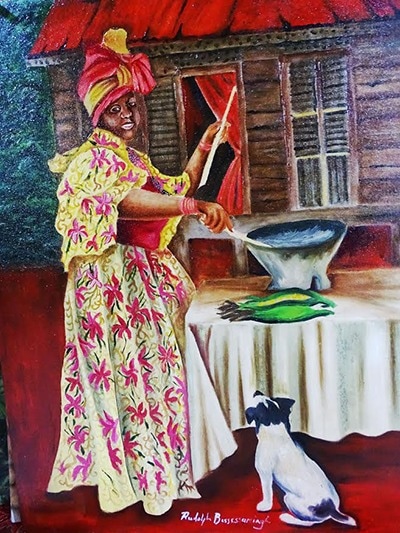 In the large houses of planters and the rich merchants of Port-of-Spain, Cook sometimes lived on the premises in a detached row of rooms in the backyard which also accommodated other members of the army of servants necessary for the functioning of a gentrified home. Alternatively, Cook lived in one of the poor tenements of barrack yards of east Port-of-Spain, especially if she had children to care for as sometimes Cook was a single mother. In the latter instance, life was one of hard work literally from dawn till dusk. A cook in a “big house” would have to take up duty at six, for at seven, the bell of the clock at the Royal Gaol on Frederick Street would toll forth and like an army, cooks from the fine homes in St Clair and around the Savannah would begin trooping down to the old Eastern Market on Charlotte Street to make their daily purchases, since in the days before widespread refrigeration, most food had to be consumed fresh. As a person of importance in a gentrified household, Cook was often dressed in a vivid Martiniquan headkerchief which, depending on the position of the knot, would announce her status as a married, single or courting woman. Equally picturesque would be the flowing skirts and flawlessly white bodices they wore as they sallied forth with empty baskets on each arm. Before 9 am, the cooks would come trooping back up from market with their baskets filled. One containing greens would be on their arms and behind them would be trailing a ragged Indian porter carrying another heavier basket holding fresh beef, oxtail to be boiled into stock, ground provisions, and sometimes fish. Depending on the type of mistress Cook served, the purchases would have to be spread out in the kitchen for Missus to poke, prod and criticise, giving the latter a sense of having done her domestic duty. After the ordeal of inspection, which would sometimes involve nagging and condemnation (sometimes accusations of mishandling household monies), Cook was free to unleash her creative juices. Assisted by a boy who lit the coalpots and a scullion who prepared the meat and vegetables for the pot (a sous-chef by modern standards), Cook would have a couple hours to serve up a three-or four-course meal to the household (luncheon was called “breakfast” in those days) before beginning preparations for dinner. Cook’s day ended at 8 pm, but she was queen of the kitchen and would benefit from macafouchette, or excess food, and sometimes clothing, which would be taken home to her own family or distributed among favourites from the cotillion of servants in the great houses of yesteryear. Fast food marketing has destroyed many of these indigenous cuisines brought from their homeland of Africa and polished to perfection in the Caribbean space. Sweets were derived from the molasses of the cane (toolum), chili-bibi; ground corn mixed with brown sugar. Guava cheese, coconut bake, coo coo, yam, ochoo sauces, roast plantain, chip chip water, pone. The sharks (American fast food), swallowed the sardines (the queens of the kitchen). Let us revisit the fact that cultural identity is deeply rooted in the foods of the natives. Jamaica is famous internationally for the jerk chicken. The bene ball is vanishing from the landscape of Tobago. Angelo’s (VIrtual Museum of T&T) writing is very relevant in relation to the dwindling foreign exchange market. Was he prophetic about cutting down on acquired foreign taste and cherishing what is clearly our own? Food for thought. Source: The Guardian, March 11, 2017.
0 Comments
Leave a Reply. |
T&T news blogThe intent of this blog is to bring some news from home and other fun items. If you enjoy what you read, please leave us a comment.. Archives
June 2025
Categories
All
|

 RSS Feed
RSS Feed